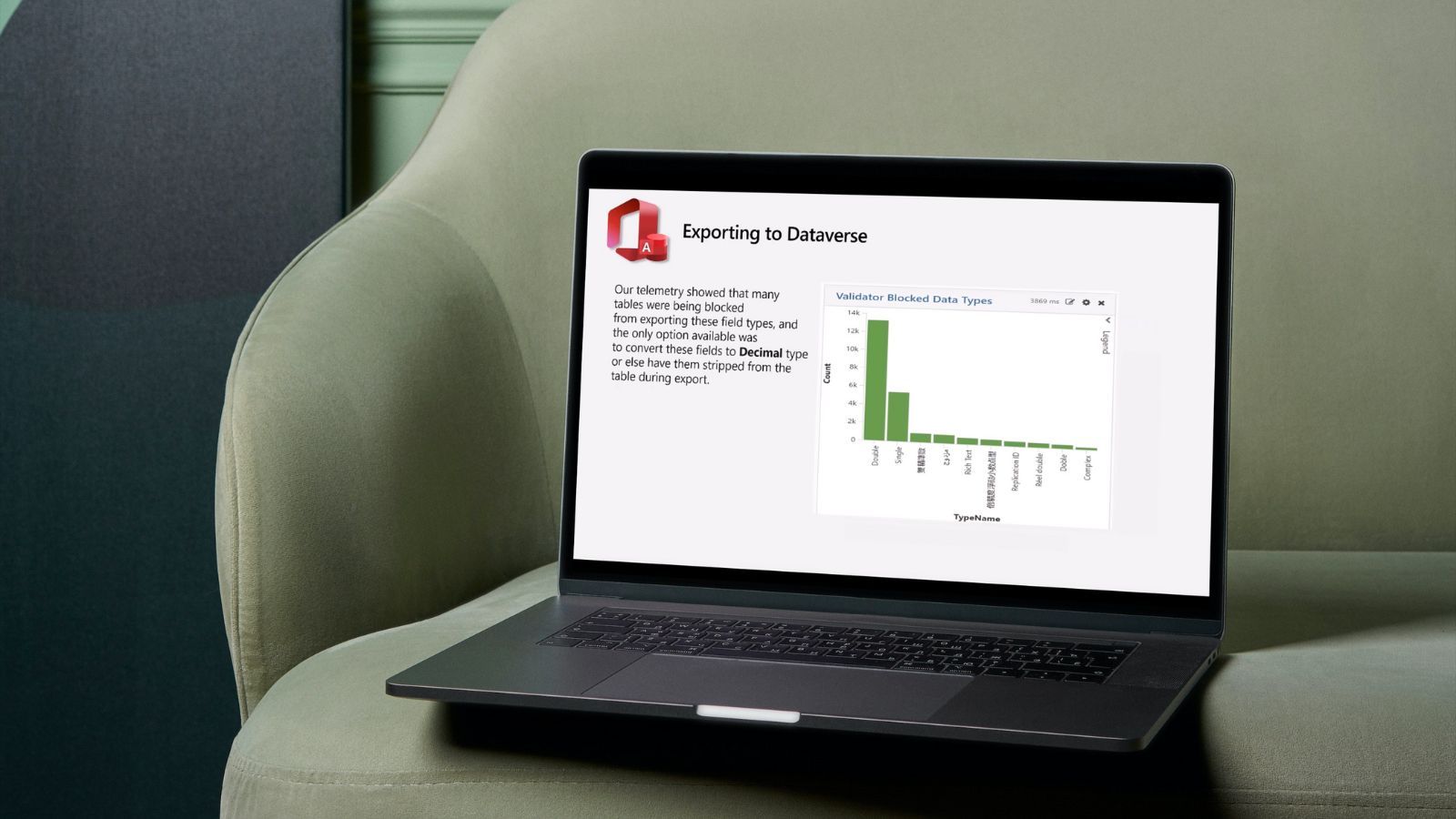Access Dev Team Progress Update: Dataverse Export Improvements
The Access team provides an update on impending improvements to the Dataverse export feature.

The Microsoft Access Engineering Team presented a feature update session to the Denver Area Access User Group (DAAUG) on November 17, 2022. The team covered four topic areas:
- New Web Browser Control
- VBA Macro Code Signing in Access
- Improvements in exporting Access tables to Dataverse
- Q&A with the new Access Prinicipal Engineering Manager, Dale Rector
Check out the full video on YouTube: New and Upcoming in Access.
Highlights
- Dataverse export support has been added for Single and Double fields.
- Dataverse versions of these fields only have five decimal places of precision.
- You will soon be able to choose a specific destination Dataverse "solution", rather than being forced into the "Default" solution.
Session Recap
Courtney Owen presented this session starting at the 11:57 mark.
He's been at Microsoft for 20+ years, including two stints with the Excel engineering team, one with the Sharepoint team, and most recently, two years on the Access engineering team.
After briefly covering his experience at Microsoft, he jumped into the changes he's been developing for the Access Dataverse export.
Unsupported Data Types
When the Access Dataverse export feature first launched, Dataverse itself did not support all the field types available in Microsoft Access.
Microsoft's internal telemetry showed that the vast majority of fields that failed to export to Dataverse were the Double and Single data types:

If you tried to export a table with either of these data types you were presented with two options:
- Convert the fields to
Decimaland retry the export - Continue exporting the table but without the
SingleandDoublefields
Neither was a particularly user-friendly option.
Dataverse now has partial support (see details below) for the Single and Double data types. In the near future, you will be able to export these data types to Dataverse.
Dataverse Default Solution
At launch, the Access Dataverse export only allowed exporting tables to the Dataverse Default Solution.
"Solutions" in dataverse are often used for application lifecycle management, with different solutions representing:
- Development
- Testing
- Production
I believe solutions can also be used for segregating projects, clients, etc. I've never done any Dataverse development, so I really don't know. ¯\_(ツ)_/¯
Soon the export will support selecting a particular solution when exporting/linking tables to/from Dataverse.
Demo
Courtney gave a brief demo showing the yet-to-be-released features in action on his dev machine.
Choosing a Solution
Choosing a solution was straightforward.
The one wrinkle that Courtney brought up was the distinction between "managed" and "unmanaged" solutions. On that linked page, Microsoft provides the following guidance:
As an ALM best practice, managed solutions should be generated by exporting an unmanaged solution as managed and considered a build artifact.
Thus, there is an ongoing internal discussion at Microsoft whether the Dataverse export feature in Access should be allowed to export directly to managed solutions or not. The current implementation DOES NOT allow exporting to managed solutions. That might easily change by the time the feature is released to the public, though.
Exporting Singleand Double Fields
Dataverse now has support for Single and Double data types.
However, there is one enormous caveat with that support:
TheSingleandDoubledata types in Dataverse are limited to only five decimal places of precision.
That is potentially a VERY big deal. This will not matter in many situations, but for those situations where it does matter, you need to be aware of it.
One additional thing Courtney pointed out is that the converted Single and Double data types only display two digits when viewed in Dataverse. However, if you link to those tables and open the linked tables in Access, you will see that they do include five decimal places of precision. Courtney raised this issue with the Dataverse team, so hopefully it will be addressed in an upcoming Dataverse release.
Resources
Courtney included the following links to additional resources at the end of his session:
- Comparing Access and Dataverse data types - Microsoft Support
- Application lifecycle management (ALM) with Microsoft Power Platform - Power Platform | Microsoft Learn
- Solution concepts - Power Platform | Microsoft Learn
Reading the Tea Leaves
Microsoft won't commit to a release month for a new feature until they are 90% confident in the date. Me? Not so much.
Based on Courtney's demo, I expect this feature to be released between January 2023 and March 2023.
My Final Thoughts
As has been the case for several years now, Microsoft is investing heavily in the Access-Dataverse integration. That's fine and all, but it's pulling already scarce resources away from other Access feature development, including the new web browser and the apparently-now-abandoned Large Address Aware support.
Personally, I can't wait until Access achieves Dataverse nirvana. Why? Well, it's not so that I can finally migrate all my Access apps to Dataverse.
I want Access to perfect its Dataverse integration so that the team can finally move on to bigger and better things.
